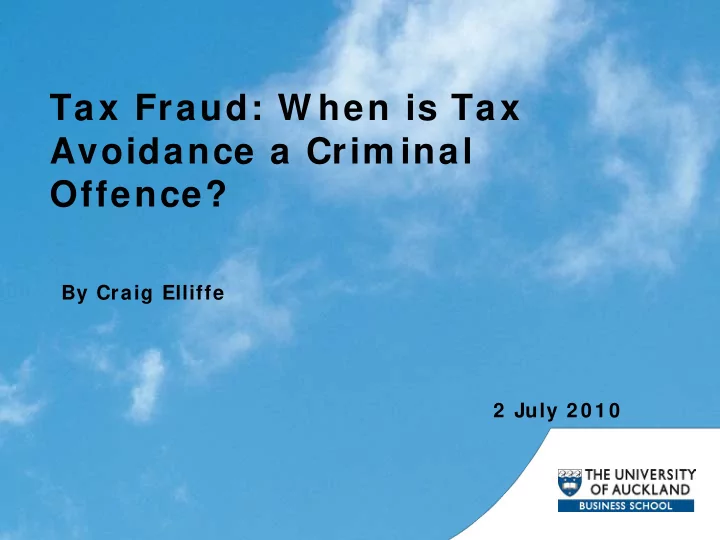

Tax Fraud: W hen is Tax Avoidance a Crim inal Offence? By Craig Elliffe 2 July 2 0 1 0
Tax Avoidance and Crim inal Acts “The difference between tax avoidance and tax evasion is the thickness of a prison wall.” Denis Healey, former UK Chancellor of the Exchequer
Observations • Tax Advisors Unfamiliar • Tax Payers Area of law • Crown/ SFO • Hayes (2008) Recent • Changes to Changes statutes • Misdirected Cases Focus on investors
Tax Avoidance and Crim inal Acts • Com pany director jailed for tax evasion Thursday, 01 July 2010 13: 55 • Evading tax of more than $700,000 has led to four years jail for a Bay of Plenty labour hire company director. • Harbhajan Singh Kahlon had been found guilty on 23 charges of GST-related tax fraud and later admitted a further 46 charges of tax evasion involving PAYE. He was sentenced last Friday in the Tauranga District Court. • Inland Revenue Assurance manager investigations Jonathan Matthews says this sentence makes it crystal clear to others considering tax fraud and evasion, that they'd better think again. • "We will catch them and there will be very serious consequences," he says.
Clever Schem es and Crim inality Section 228 Crimes Act “intent to obtain any... pecuniary advantage.. Dishonestly and without claim of right uses any document Intending to evade the assessment of tax Criminal Offences Section 143B Tax Administration Act “Knowingly providing false, incomplete or misleading information” Obtaining a refund in the knowledge of no lawful entitlement
Section 2 2 8 Crim es Act 1 9 6 1 Use of a document (tax return) • To obtain a pecuniary advantage With the intention to obtain property • Through the dishonest use of the document That the accused had no claim of right
Dishonestly, w ithout claim of right Hayes v R (Supreme Court 2008) “belief” assessed without reference to reasonableness (Robin Hood) or honesty
Reasonableness If belief was qualified by the word “honestly”- two problems • Reasonableness: Genuine belief in lawfulness even if unreasonable is not caught by section 228 Overcomes the problem of someone framing their own moral code • Will impact on the evidentiary credibility
Application of section 2 2 8 Tax return used Assessment of the facts to see if the taxpayer genuinely To obtain a believed they were refund entitled to the claim (pecuniary (reasonable doubt advantage) Did not that they had a believe mistaken belief) entitled to a refund
Features of tax avoidance Non- commerciality Difference between legal Concealment and economic effects Artificiality
Australian decision R v Pearce $39000 (deducted) Investors Servcom $10000 $29000 Loan (NR) MAGICA/ Advisors and Allied accountants Securities
Com m on Features of tax avoidance and crim inal offences Artifice Lack of Commercial Rationale
Com m on Features of tax avoidance and crim inal offences Fees and Remuneration Role of the Advisor
Conclusion Risk associated with aggressive transactions Cloaking the real transaction, artifice and dishonesty (may be consistent with both tax avoidance and criminal activities) Lack of belief in legality (from a section BG 1 perspective) could be sufficient establish requisite criminal mens rea (intent) This could be evidenced by clear statement that the transaction was for the sole purpose of tax
Recommend
More recommend